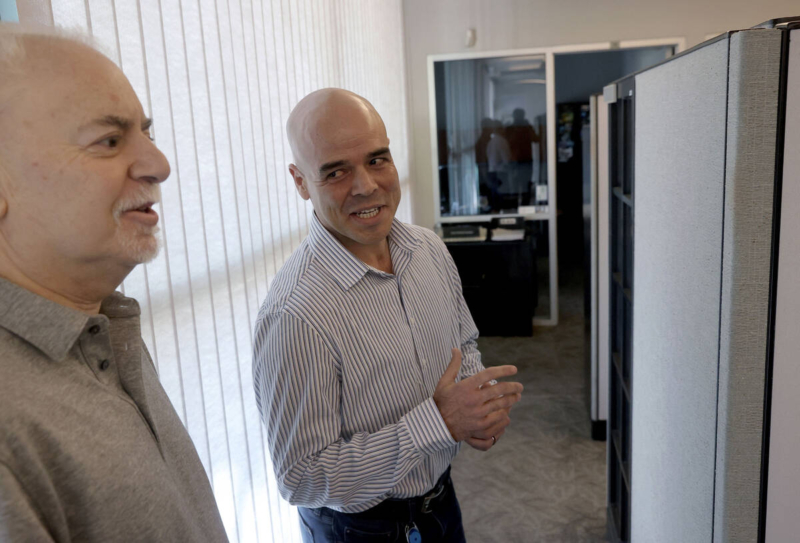In 1978, forty-four years before Jeff German was murdered, he left Milwaukee for a job at the Las Vegas Sun.
Every mid-size city has a reporter like Jeff German. Though perhaps not one who died for his work in the same way he had once lived for it. And perhaps no longer, as local newspapers are bought up and stripped, merged into one another for profit, or turned into outlets for tribal politics.
At the start of German’s career, journalists were enjoying the reflected glory of Watergate. Being a reporter was a glamorous and admired feat. The Sun’s open-plan newsroom rattled with the sound of hard typing and perpetually ringing landlines.
The paper was owned by Hank Greenspun. His family had fled pogroms in Poland. In 1946, he himself fled Brooklyn for Vegas, when it was still a small town with mostly dirt roads, and life as an arms smuggler for the Israeli paramilitary group Haganah, and a nascent publisher. Even as he became a wealthy and connected man, through his real estate and cable businesses, he felt he stood for the little guy.
Mike O’Callaghan, the executive editor of the paper, was a former boxer who had lost a leg in the Korean War but retained the aura of a fighter. He served for two terms as governor of Nevada, from 1971 to 1979. He was reelected in a landslide for his second term and could have run for a third, but chose to step down. People thought he would run for Congress. But he decided to get into the newspaper business.
German idolized O’Callaghan and Greenspun, and German’s persona seemed like a reflection of their stories. He would go around the office telling people he was working on “something big.” “He didn’t do small stories in his mind,” says Geoff Schumacher, a historian who worked at the Sun as an editor at the same time as German. In the eighties, German wore a gold chain, and he drank with local gangsters he hoped to foster as sources. He wrote stories about Mob violence and the men behind it, and he visited the casinos at night to develop sources. “He was the epitome of the aggressive journalist,” says Schumacher. “He was the reporter who knew how to get the information.”
In 1999, he reported that the owner of Binion’s casino, Ted Binion, was murdered by his girlfriend Sandy Murphy. “The Binion thing was his crown jewel,” says Art Nadler, a close friend of German’s who joined the paper around the same time. German wrote a book based on his reporting called Murder in Sin: The Death of a Casino Boss, which eventually got turned into a Lifetime movie called Sex and Lies in Sin City.
Outside the newsroom, German hung out with reporter friends at a TGI Fridays. He was described euphemistically as “prickly.” He sent food back at restaurants. Politeness was beneath him. “If the conversation wasn’t about him or things he was interested in, he would leave,” says George McCabe, another long time colleague and friend of German’s. But McCabe and others remembered a softer side to German. He’d always call on their birthdays.
German reveled in beating the other big paper in town, the Las Vegas Review-Journal. When the Sun came off the presses, says Glenn Cook, who was a reporter at the Review-Journal at the time and later became its editor in chief, they’d look to see what German had written. “There would be a groan or a sigh at the big story he had gotten,” Cook says.
An ad for the Sun included a picture of German with his hair brushed back into a puffed helmet, his chin propped on his hand, glasses resting on his nose. “Jeff German,” read the advertisement. “When you want the facts!”
In 1989, Hank Greenspun died. Shortly afterwards the Sun signed a joint operating agreement with the Review-Journal—the Review-Journal would keep 90 percent of the profits and the Sun would keep 10. The Review-Journal would now be the only paper to publish in the morning, while the Sun would publish in the afternoon. The Sun diminished, losing readership, revenue, and resources.
In 2004, Mike O’Callaghan died, and with him an era. The advent of the internet meant the death of classified ads in the newspapers. In 2005, the Sun’s circulation had dropped to about thirty-five thousand. Hank’s son Brian Greenspun revised the JOA, and the Sun began to be published as an insert in the Review-Journal. It wasn’t enough. There were large-scale cuts in staff.
Every paper across the country was having to figure out a new identity for itself. German, say those who knew him, was not ready for the change. He lived in a bubble of his columns and his reporting. No one thought German would be fired. But then, in 2009, he was. It left him completely unmoored. He had centered his entire world around his identity as a Sun reporter. He took small gigs writing content for websites.
The Review-Journal had scooped up journalists from The Sun before, and German—with his deep well of sources and reporting record—should have been an easy hire. “It took months with Jeff hanging out there unemployed,” says Cook.
In 2010, the Review-Journal hired German. They put him on the court beat at first, a step back for a front-page reporter. He shared a crowded office in the courthouse with another Review-Journal reporter. The experience of being at sea seemed to have transformed German. “He comes in the door energized, grateful, and collaborative. He very quickly was absorbed into the social fabric of the newsroom,” says Cook.
In 2015, a few minutes before an all-staff meeting, the paper’s publisher took its editor Michael Hengel aside and told him the paper had been sold. But he would not say who had bought it. In the staff meeting the publisher repeated the message to a roomful of journalists who immediately responded with a barrage of questions. In the next week, a core team of those journalists turned their spotlight on their own paper.
They helped reveal that the new owner was the casino magnate Sheldon Adelson. In 2016, Adelson gave $25 million to Donald Trump’s presidential campaign. His fortune stemmed from an empire of gambling establishments in Macau that played off the reputation of the Venetian, the casino he owned in Vegas. He was litigious toward journalists and had already sued one of the Review-Journal’s columnists, John Smith, into bankruptcy by the time he took over the paper.
The paper endorsed Trump in 2016, and Adelson’s wife, Miriam, published op-eds celebrating Trump’s support for Israel and lauding her late husband. A raft of journalists left the Review-Journal, including the team that had investigated its ownership. But German kept working there. And soon after the takeover he was assigned to a new dedicated investigative team. In 2017, after Stephen Paddock opened fire on a crowd of concertgoers on the Las Vegas Strip, killing sixty people, German won the trust of Paddock’s brother, and spent days driving him around, getting to know him. He eventually broke the news that Paddock had also shot bullets into large jet-fuel tanks nearby, perhaps in an attempt to cause an explosion.
Around that time, German was diagnosed with kidney cancer. He gave up alcohol and steaks and bought a small one-story home in the suburbs. He filled it with tchotchkes and tended to its plants.
The Saturday before German was murdered, he and McCabe had one of their regular breakfasts. German ordered an egg-white omelet and began to tell McCabe about a story he was chasing.
It focused on Robert Telles, a Clark County public administrator. His employees accused him of bullying and of having an affair with a subordinate. McCabe listened skeptically. He told German that Telles sounded like a page 3B story—that he should be out chasing bigger fish.

Clark County Public Administrator Robert Telles, right, talks to Las Vegas Review-Journal reporter Jeff German in his Las Vegas office on May 11, 2022. (K.M. Cannon/Las Vegas Review-Journal/Tribune News Service via Getty Images)
But German had bonded with the women at Telles’s office, who had told him how they had suffered. He wanted to do the story for them. German published story after story about Telles’s misdeeds. On June 18, Telles posted on Twitter that he was “looking forward to lying smear piece #4 by @JGermanRJ. #onetrickpony I think he’s mad that I haven’t crawled into a hole and died.” Weeks later, Telles lost his reelection bid. But German continued to report.
On September 2, at 11:18pm, a man drove an eggplant-colored GMC Denali to German’s house. He wore a wide-brimmed straw sunhat, a bright orange reflective jacket, and light-gray Nikes and carried a duffel bag. He entered German’s backyard through a side gate. Five minutes later, the garage door opened and German walked out.
The man in the straw hat stabbed German four times in the neck and three times in the torso. One of the cuts slashed German’s carotid artery. Minutes later he died. The man got into the Denali and drove away. At 11:30pm he returned and walked to where German’s body was lying on the ground. Then he left for the final time.
At the offices of the Review-Journal David Wilson, a young reporter, was on call on the crime beat when the news came through of a homicide. He left the Review-Journal’s offices and got in his car to drive to the police press conference. On the way, his editor called him and said, “We don’t know for sure. But we think it might be Jeff.” During the press conference, he focused on making sure he got the correct dates, names, and times. He began writing the article in his car when his phone rang again. “It’s confirmed,” said his editor. “Don’t tell anybody, just file your story.”
The police released a picture of the man in the straw hat, and David Ferrera, a close colleague of German’s, identified Telles. Then a friend sent Ferrera a picture of Telles washing an eggplant-purple Denali that exactly matched the one driven by the suspect.
On September 7, the police raided Telles’s home. Samples taken from under German’s fingernails matched Telles’s DNA. They found cut-up pieces of bloody shoes stuffed into a plastic bag and hidden under Telles’s couch. Pieces of the straw hat were found in a toolbox in his garage. On October 20, a grand jury indicted Telles for German’s murder.
It was an ignominious death for someone who had covered some of the most salacious Mob murders, but it did mean that Review-Journal reporters found themselves inundated with calls and emails from reporters like me who wanted to know about German. “I wish he had been appreciated as much in life as he has been in death,” says McCabe.
There were court documents on his desk when he died. Washington Post reporters used them to start investigating an alleged Ponzi scheme targeting Mormons, and the resulting stories were the last he contributed to.
German’s old friend Nadler told me to go to the Neon Museum to get a sense of what Vegas was like during their golden years. It’s supposed to be a graveyard of abandoned lit-up signs assembled from decades of changing casinos, bars, and restaurants. A flavor of Vegas before it became drive-in Starbucks and strip malls floating in the desert. When I got there the museum was closed and the lights were out.
Correction: An earlier version of this story erroneously stated that Mike O’Callaghan lost a leg in the Vietnam War. It was, in fact, Korea.
Pesha Magid was a CJR fellow.

